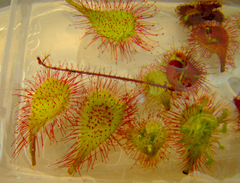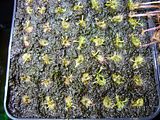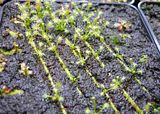|
|
Post by richardhole on Dec 8, 2010 1:50:44 GMT
|
|
|
|
Post by richardhole on Dec 9, 2010 11:54:10 GMT
Hello
Is there much benefit in washing the leaves first before soaking them in the distilled or demineralised water? It is just that it takes a fair bit more time and it could damage the leaves. I tried washing some and they had to be rubbed fairly hard between my fingers under the tap to remove the insects on the leaves. It bent the tentacles and may have broken some of them. Another issue is that if they are washed under the tap, a small amount of tap water would be transferred on the leaves into the distilled water that they are soaked in. Also there would be a few drips of tap water on the washed container. Could a small percentage of tap water like this be a problem and likely to make much difference? The leaves and container could be rinsed again in a dish of purified water. However, this would take more time. Bear in mind our tap water is reasonably good and fit for human consumption. However, it is chlorinated.
I found the leaves of the Drosera Capensis (broad form) floated in the water near the surface. However, some of them floated on their sides and drifted so they touched the other leaves in the container.
Any comments on my earlier posts would be appreciated.
Your help is appreciated
Regards Richard.
|
|
|
|
Post by Joseph Clemens on Dec 9, 2010 16:29:57 GMT
Yes, I have found washing to be important, leaves would be damaged where insect bodies touched them and they seem to inspire lots of algae and other microorganism growth.
Washing techniques vary - I wash Drosera leaves by using a stainless steel screen sieve and a plastic spray bottle filled with purified/demineralized water. I put the sieve over an empty container (to receive the wash water and dirt/contaminants), then adjust the spray nozzle to a coarse spray pattern. This allows the contaminants to be washed from the leaves with the least amount of damage. Be careful to adjust your technique to wash the leaves and keep damages to a minimum. It is possible to spray so hard as to rupture the leaf tissues, but it is easily possible to dislodge and wash away contaminants with almost no damage to the leaves.
|
|
|
|
Post by richardhole on Dec 9, 2010 17:20:49 GMT
Hello
Do you lightly rub the leaves on the stainless steel screen sieve or with your fingers as well? It is just that I found that letting water run over them would not remove the insects. The leaves had to be rubbed with my fingers. I would expect a spray to be less powerful and cleaning than putting them under a tap where there is a greater volume of water.
Also, have you compared the number of successful strikes (or number of plantlets formed per X amount of leaves) when you did not wash the leaves to when you did wash them and if so what was the difference?
Your help is appreciated
Regards Richard.
|
|
|
|
Post by Joseph Clemens on Dec 9, 2010 19:07:45 GMT
No rubbing, none at all. I simply adjust and maneuver the spray from the bottle to provide concentrated spray force to remove the detritus without doing much, if any, harm to the leaves. I find that the force and speed I use to depress the spray lever, directly translates to the force of the spray exiting the sprayer nozzle. This quickly and easily cleans nearly all detritus from the leaf surfaces, even from the tentacles without harm. I've also discovered that if I'm not careful to tweak my angle, distance, and force of spray, I can transfer too much force directly onto the leaves, causing them damage. So, we're not talking about a gentle spray, but a quick and forceful one. It will probably take some practice before you get it just right.
You may also be able to use the wire strainer with the faucet. I'm sure many different techniques could be improvised and used successfully - the spray bottle was the one that worked for me. I tried using a faucet, but I liked having better control of the process with the spray bottle.
- - - -
At first I started without washing, but didn't like how some leaves would rot from the insect bodies, also mold and algae would grow from them and cause problems of their own. It wasn't always a matter of more strikes, but often a difference of some -vs- none, and a yucky mess.
|
|
sundewman
Full Member
Happy Growing!
Posts: 235
|
Post by sundewman on Dec 9, 2010 19:14:59 GMT
Richard, the difference with having debris in the leaves versus having clean leaves is that you won't get mold and you won't have to change the water nearly as often. Growing mine indoors, I don't have to change the water at all- I had cuttings submerged in the water for 2.5 months without a single spec of mold. There is also no reason that you should worry about submerging them. If anything, submerging in water will make the leaves last longer, from what I've seen. The only benefit that I recently thought of with why some people have better luck adding sphagnum is that it might provide acidity to the water, which encourages striking. But my tap/RO water works perfectly fine, so I'm not sure why a few other people were having problems. ------------------ Just take leaves from the plant that are newer, and have minimal insect debris. Taking newer leaves doesn't hurt the plant if it is healthy, so I don't think you should worry about it. I even think Capensis and the easier ones would be fine if all the tentacles were carefully removed or trimmed off. Haven't tried this though, but I think leaf cuttings are a lot easier than you think. If the leaves are tentacle side down, it makes potting them slightly harder, but it is not a problem at all. They still bud and then grow against gravity, so they kind of curl upward from under the leaf. I've also used pure tap water with the same amount of success as distilled. It does not matter unless the ppm was extreme or something. If anything, the small amt of chlorine just acts to prevent mold and algae- it's not in a high enough concentration to harm the plant. The jar works great, but if you're really concerned about it, then you can use a shallow, clear dish or something. I use a clear case for a deck of cards, which allows me to submerge them and have them in a small slot under my fluorescent fixtures indoors:  |
|
|
|
Post by richardhole on Dec 10, 2010 0:22:51 GMT
Hello
If the bugs are hard to remove with a spray, what I may be able to do is get the hand sprayer and adjust the nozzle so there is a narrow jet of high pressure water and try to target the bugs on the leaves if there are only one or two. That way the leaf could only get damaged where the bugs were. For the other parts of the leaf where there are no bugs I could only give them a light spray. Another option would be to cut out the parts where the bugs are. I read that the leaves can be cut into pieces. Is this just as affective at getting strikes for the sundews with longer leaves like Capensis and Adelae?
The leaves I tried floated on the surface. Parts of some of the leaves were above the surface.
An option could be to only put about 3mm of water in the container so that leaves touch the bottom of the container and remain tentacle side up. Could this be worth a try? However, if I did this some parts of the leaves may be totally above the water. However, if the container is sealed this may not matter.
Your help is appreciated
Regards Richard.
|
|
Richard Davion
Full Member
Having-Problems Taking-OUT Another [4]-Years-of-MEMBERSHIP Why-Does-It Have-To-Be Soo-'Hard' Fellahs
Posts: 219
|
Post by Richard Davion on Dec 11, 2010 15:44:41 GMT
Using The-Power-of-The-Internet "I"-Pulled The-Following 'Rough'-Data for Tucson-Water: Aluminum: 0.05 to 0.2 mg/L Chloride: 250 mg/L Color: 15 (color units) Copper: 1.0 mg/L Corrosivity: noncorrosive Fluoride: 2.0 mg/L Foaming Agents: 0.5 mg/L Iron: 0.3 mg/L Manganese: 0.05 mg/L Odor: 3 threshold odor number pH: 6.5-8.5 Silver: 0.10 mg/L Sulfate: 250 mg/L Total Dissolved Solids: 500 mg/L Zinc: 5 mg/L Secondary Standard Your-Water's Got-about 1/4-of-R-Gram (250ppm) of Chloride as-Well-as Sulphate per-Litre In-It!!! It-Also Has-about Half-R-Gram Per-Litre of Undefined Dissolved-Solids. I've Also-Noticed that Your-State Produces R-Lot of Zirconium-Copper ... Presumeably Because you Have Large-Deposits within The-State Since-"I" Have Also Noticed Mention of Dissolved-Zirconium in The-Water. I've Temporarily 'Forgotten' ... but isn't Zirconium-chloride 'Used' in The-Aquarium / Fish Industry to-Remove Something from Tank-Water!!!  >(*~*)< Donald-Schnell Mentions-In His Second-Book That Sailors Use-to Cart Kegs many-Miles Inland to-Harvest (Obtain) "Pocoscin"-Water ... For-it Remained 'Potable' on-Board-Ship Months-Longer than 'Normal' Stream-Water. Presumeably It's The-High Aluminium-Content at-Work Here. |
|
|
|
Post by jj1109 on Jan 7, 2011 1:25:30 GMT
If anything, the small amt of chlorine just acts to prevent mold and algae- it's not in a high enough concentration to harm the plant. This is a great thread! I will be trying this this weekend, I think. Just a comment on the above quote, the chlorine would evaporate within a day anyway, even in a sealed container, I would think. We're talking such tiny volumes that there's really very little chlorine in there. |
|
|
|
Post by jesser on Jan 7, 2011 12:29:00 GMT
This is a great thread! I will be trying this this weekend, I think. But don't you think that "floating in water" is the only way to be successful with Drosera leaf cuttings because everybody in this thread is talking about water, water and water as his favoured method. With my hardy drosera I always put the leaf cuttings on pure peat (cuttings taken early in the growing season), keep the peat wet and give it some artificial lighting in the house or a shady place in the garden. Leaf cuttings D. intermedia (Carolina Giant):  Leaf cuttings D. filiformis:  Leaf cuttings D. rotundifolia:  And finally ready for planting in my bog garden (D. x beleziana and D. rotundifolia):  |
|
|
|
Post by richardhole on Feb 10, 2011 17:17:21 GMT
Hello
Some of the leaves I have had floating in water only produced one plantlet after about 6 weeks.
Do you suggest cutting the plantlets off the leaf cuttings soon after they produce roots and then putting the leaves that they have been cut from back into the water again so new plantlets may form? Note, the leaves may have some parts cut from them where I remove the plantlets in order to avoid damaging the plantlet.
Or alternatively should I leave the plantlets grow until they are fairly large for a few months so that more plantlets will get time to form and then cut them all off together to plant?
Your help is appreciated
Regards Richard.
|
|
|
|
Post by Joseph Clemens on Feb 11, 2011 6:03:12 GMT
I've done it both ways. But sometimes a leaf only produces just a few, or only one plantlet.
|
|
|
|
Post by richardhole on Feb 11, 2011 23:32:29 GMT
Hello Joseph and those interested,
Do you find either way works just as well as the other?
Do you think it would be worthwhile putting a leaf back in the water again after the plantlet and a small part of the leaf is cut off?
Your help is appreciated
Regards Richard.
|
|
|
|
Post by Joseph Clemens on Feb 12, 2011 5:01:01 GMT
Either water or surface of media can work equally well. One media method includes holding the leaves flat against the media surface with cheesecloth stretched over the media surface with the leaves between the media and cheesecloth.
If most of the leaf still looked like new, I'd put it back in. If the leaf looked like it was too old to keep going - I'd retire it and start another fresh leaf.
|
|
|
|
Post by richardhole on Mar 29, 2011 5:31:59 GMT
Hello
I put some Drosera leaf cuttings in water over 3 months ago. Some of the plantlets are about 1 centimeter long but have produced few if any roots. Should I wait a couple more months for roots to form before I plant them out or after this length of time would you suggest planting them even if the plantlet has no roots? On an earlier post you suggested the plantlets grow better if they have roots in the water before they are planted. However, I thought that the time sitting in the water may have to be taken into consideration. I am happy to wait so long as it is not best to plant after a certain time period and so long as the plants continue to grow in the water. If there is a maximum time limit in the water you suggest what is it? We are currently in the Autumn.
I could plant the ones out that have roots and leave the others that do not have roots if you suggest that? I have had Drosera Capensis, Adelae, Spatulata, and Venusta to strike in water by leaf cuttings.
Your help is appreciated
Regards Richard
|
|







